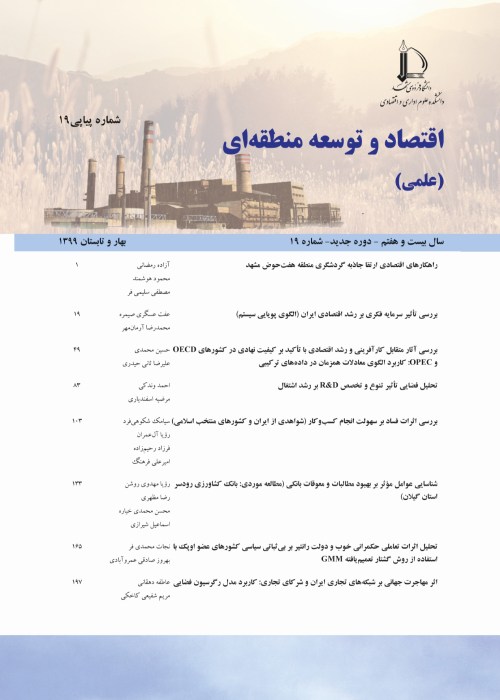Spatial Analysis of diversity and R&D specialization impacts on employment growth
Recently, the role of industrial structure on regional employment has attracted much attention. One of the branches of these studies, focusing on Jacobs (1960), suggests that more diversity of industrial structure leads to employment and protects the areas against the adverse effects of external shocks. Jacobs's hypothesis has been validated experimentally in many studies. These studies provide a positive relationship between regional economic diversification and employment growth. Following the increasing trend of studies related to economic diversity on employment growth, regional employment models have also been focused on considering spatial dependency. In terms of industry structure, the more diverse areas can be benefited from their externalities, while more diversity within a region improves technical innovations and their impacts. According to Iran's provinces' employment rate, we found a significant regional dispersion between different regions. Although regional employment growth has received more attention from scholars and policymakers than ever before, few empirical studies have been conducted on the relationship between R&D specialization and diversification and regional employment growth. Therefore, this paper aimed to investigate the spatial effects of R&D specialization and diversification on employment growth in the Iranian provinces from 2005 to 2015.
For this study, R&D specialization and diversification in Iran's provinces were first measured, and then the spatial effects of each of these variables on the employment growth of Iranian provinces were estimated using an econometric model. According to Chen& et al. (2015), the Gini index has been used to measure the degree of R&D specialization. Following Ocaner et al. (2018), total diversity is measured by total entropy and related and unrelated diversification.
Given that this study's spatial unit of choice is based on administrative boundaries rather than economic regions, it might be expected that spillovers would exist from the neighboring region. So a full Spatial Durbin Model (SDM) specified, which takes the form of the following: (1)The SDM allows for the observed value of neighboring region employment growth () and other regional characteristics of neighboring regions' employment () to impact a regions’ employment growth rate. The coefficient shows the impact of employment growth in neighboring regions on the employment growth rate of a particular region or, in other words, the spatially lagged dependent variable. (Ocaner et al., 2018)According to Table 1, the results of the estimation of equation1 showed that employees in the sector of services and relevant or irrelevant specialization and diversification had a significant positive effect on employment growth so that the effect of specialization was more than that of irrelevant diversification and the effect of irrelevant diversification was greater than that of the relevant diversification.
Conclusions and Suggestions:
The findings of this study supported the Jacobs hypothesis for the Iranian provinces. Also, there was a reverse U-shaped relation between economic specialization and employment growth, indicating that as R&D specialization increased, provincial employment growth increased, but the specialization led to a decrease in employment growth at higher levels. Therefore, as R&D specialization increased, productivity increased, and it was replaced by employment growth. So, the Marshall hypothesis was supported by a range of specialization. For more precise analysis, direct, indirect, and total effects have been calculated. The indirect effect measures the effect of changes in the region j on the dependent variable in region i, which i≠j. The direct effect measures a particular explanatory variable in region i on the dependent variable in region i. The calculation of direct and indirect effects showed that increasing R&D specialization in one region could affect employment growth of the same region; however, it had no significant effect on the adjacent regions' employment growth. Increasing the irrelevant diversification in each region also led to employment growth in the same region, but increasing the relevant diversification in the adjacent regions resulted in a decrease in the host region's employment growth.Increasing the average income of the adjacent regions decreases the host region's growth rate and leads to the host region's employment growth. Thus, the limited influence of entropy related to the growth of provincial employment indicates evidence of transmission mechanisms between regions. Indirect results indicate a significant spatial spillover, and the evidence from estimating direct effect indicates that geography is essential in terms of neighborhood zones. Therefore, in developing programs and policies of increasing employment, it is necessary to pay attention to the potentials of the region and the influence of neighboring areas. It is suggested to deploy industries with more diversity in provinces with lower employment rates. So, creating industrial clusters as a unit for all of the provinces is not a suitable policy. Also, increasing the specialization index by increasing R&D expenditures in areas with a high unemployment rate can increase employment. From this perspective, granting specific and increasing tax credits to the firms in exchange for R&D can be helpful in increasing the employment rate of the province.
- حق عضویت دریافتی صرف حمایت از نشریات عضو و نگهداری، تکمیل و توسعه مگیران میشود.
- پرداخت حق اشتراک و دانلود مقالات اجازه بازنشر آن در سایر رسانههای چاپی و دیجیتال را به کاربر نمیدهد.



